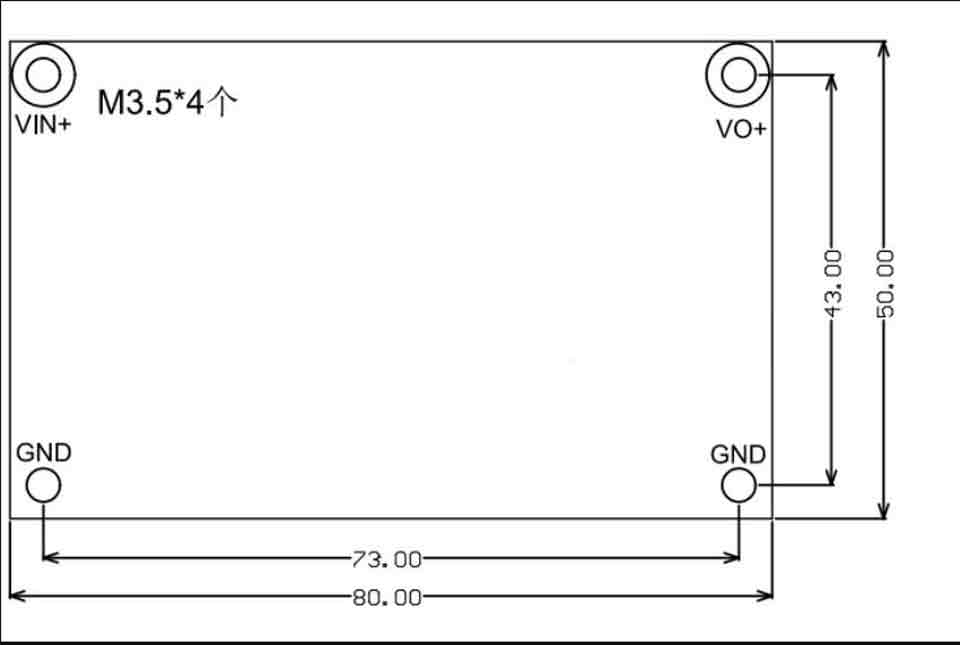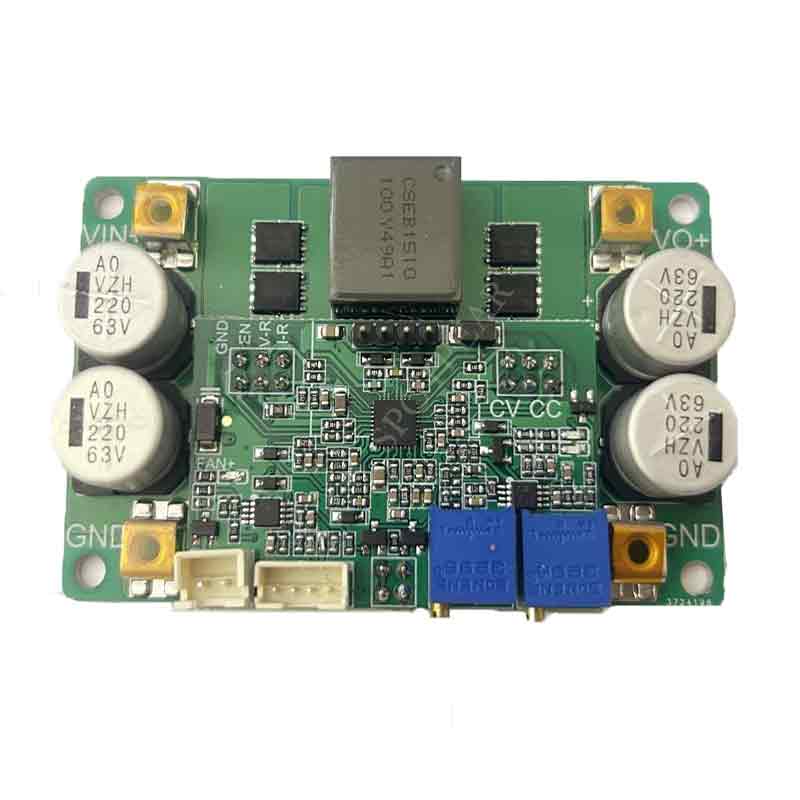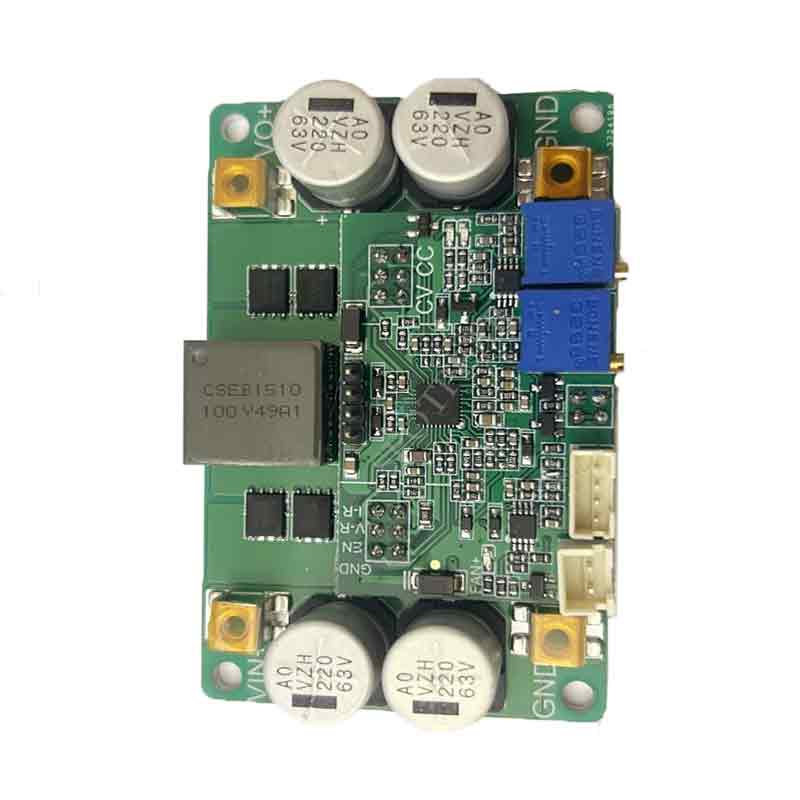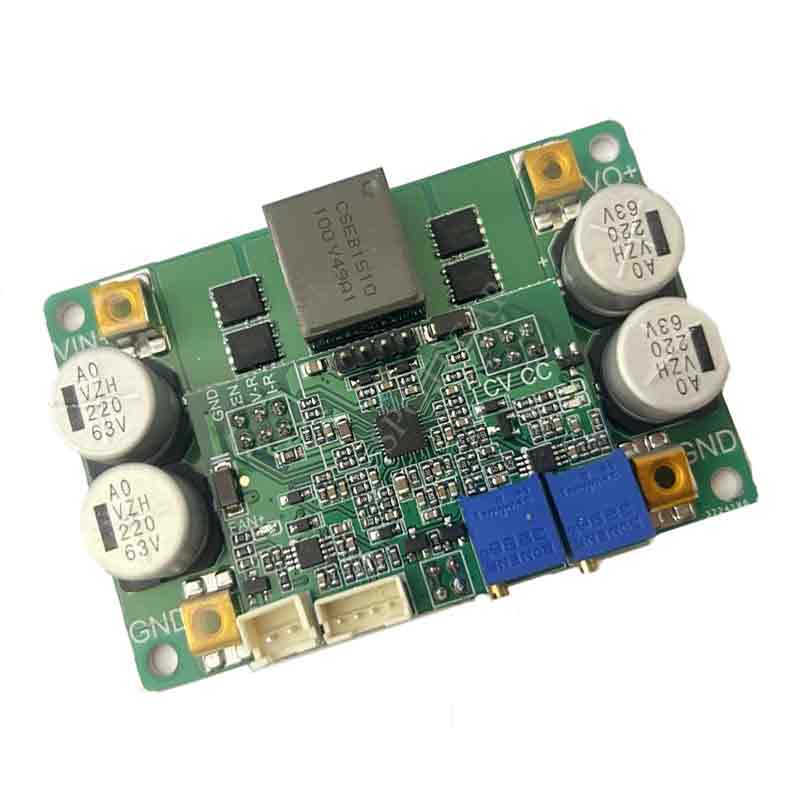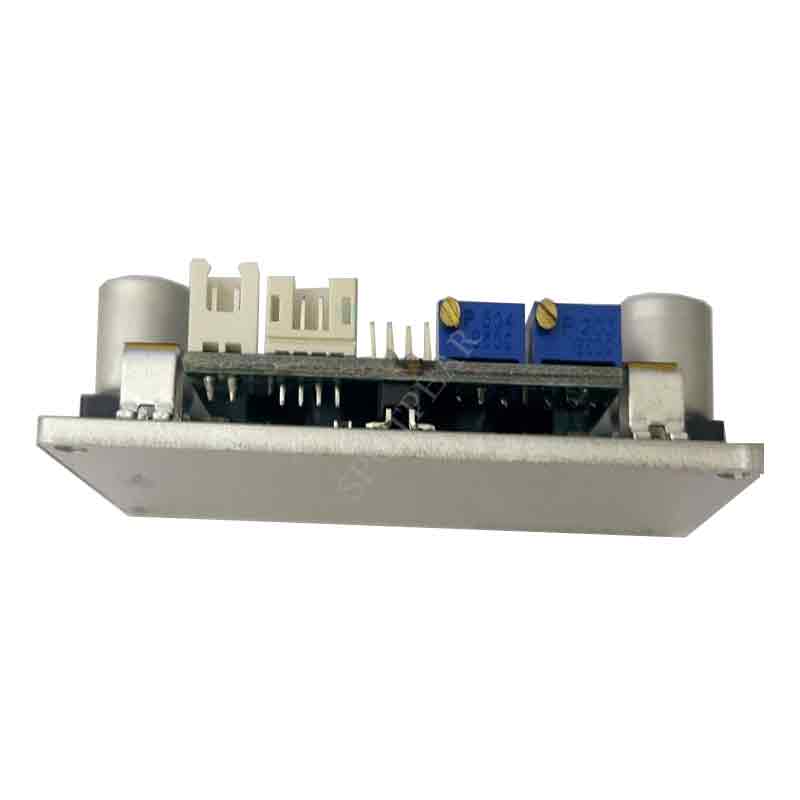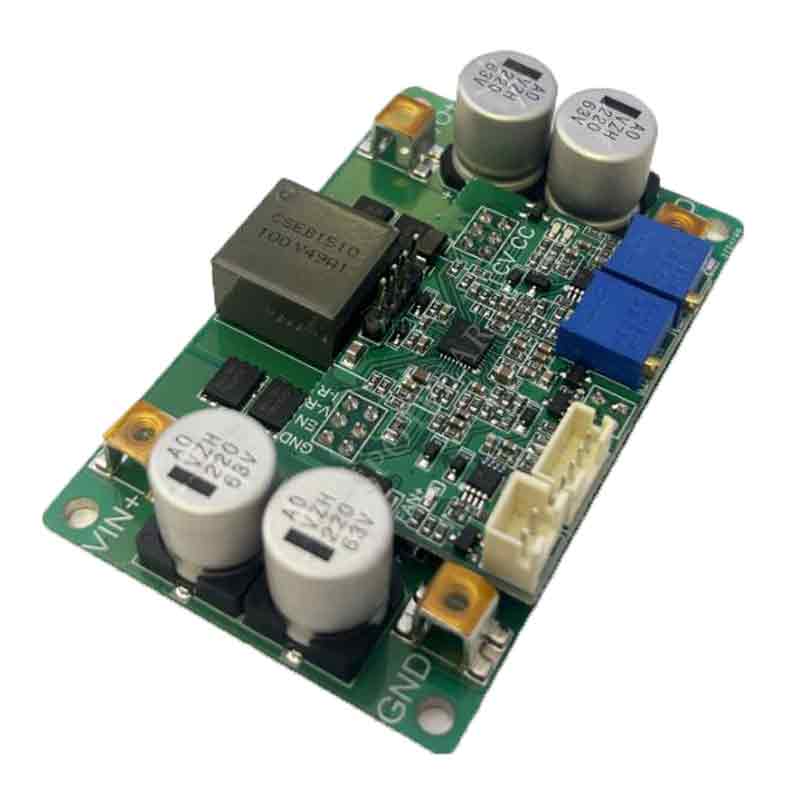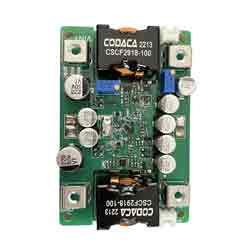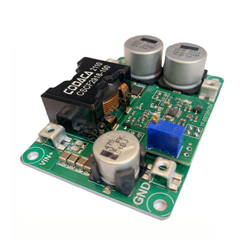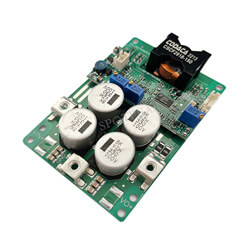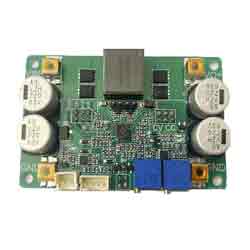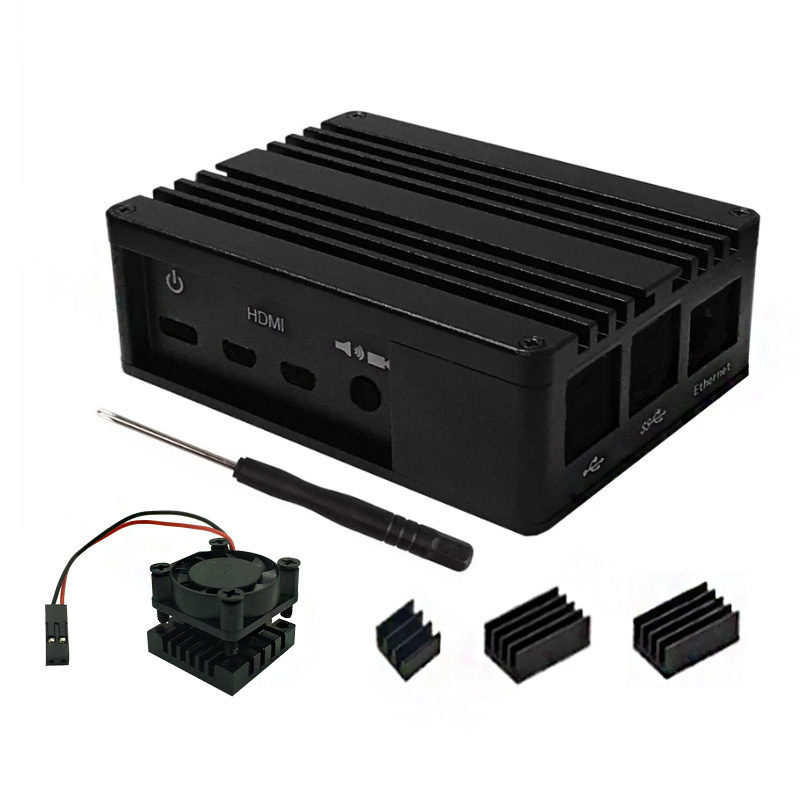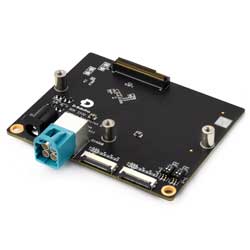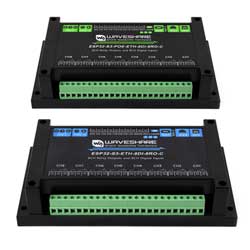- sales/support
Google Chat: zj734465502@gmail.com
- sales
+86-0755-88291180
- sales01
sales@spotpear.com
- sales02
dragon_manager@163.com
- support
tech-support@spotpear.com
- CEO-Complaints
zhoujie@spotpear.com
- sales/support
WhatsApp:13246739196
- HOME
- >
- PRODUCTS
- >
- Common Module
- >
- Power
Two-way DC automatic step-up step-down power supply module Constant current 9-56V/2-20A
$35.9
Two-way DC automatic step-up step-down power supply module Constant current constant voltage battery charging 9-56V/2-20A
Power Module Recommend
【Note】
[] Do not use a laboratory adjustable power supply with 3A output to test this power supply.
[] Do not test the current-limited power supply using the CC mode of an electronic load.
[] The adjustable range of the output current regulation means that under the condition of sufficient input power, if the output voltage of the power supply is set to 20V and a 0.4Ω resistor is connected to adjust the CC potentiometer, the output current can only be adjusted within a range from the minimum to the maximum of 50A, and cannot be adjusted to the lowest limit value (except for 0A).
【Features】
[] Non isolated four switch synchronous buck boost
[] Wide input DC9-58V, output DC3-56V
[] Peak efficiency>98.0%
[] Overcurrent protection and short circuit protection self recovery
[] Remote ON/OFF
Over temperature protection
Optional temperature controlled fan
[] Constant current indicator light
Adjustable output voltage and current
Maximum inductance current of 20A
Fast dynamic response, high voltage stabilization accuracy, constant frequency operation MEI for easy prediction
Power can exceed 450W (input and output>24V)
No special specifications, all tests are conducted at 24V input voltage, pure resistive load, and 25 ℃ room temperature
【Specifications】
[] Absolute maximum value: ABSOLUTE MAXIMUM Ratings:
[] Input voltage: minimum: -1V, typical: none, maximum: 60V Remarks: continuous
[] Output voltage: minimum: -1V, typical: none, maximum: 60V
[] Power shutdown interface EN: minimum: 0.7V, typical: none, maximum: 30V
[] External voltage control interface: minimum: 0, typical: none, maximum: 5V
[] External current control interface: minimum: 0, typical: none, maximum: 5V
[] Fan interface current limit (optional): minimum: none, typical: none, maximum: 0.35A
[] Storage temperature: minimum: -45 ℃, typical: none, maximum: 125 ℃
[] Aluminum substrate and current foot withstand voltage: minimum: none, typical: 300V, maximum: 500V
[] Maximum torque of screw short nut: minimum: none, typical: 0.5N.m, maximum: 1 N.m
[] Rotation life of Potentiometer: minimum: none, typical: none, maximum: 200 cycles
[] Recommended parameters:
Input voltage: minimum: 12V, typical: none, maximum: 56V
Input current: minimum:/, typical: 2A, maximum: 20A
Output voltage: minimum: 3V, typical: none, maximum: 56V
Output current: minimum:/, typical: 20A, maximum: none
[] Input characteristics:
Input working voltage range: minimum: 9.0V, typical:/, maximum: 58V
Input undervoltage protection adjustable range: minimum: 6V, typical: 9V, maximum: 50V
Undervoltage protection hysteresis value: minimum: 0.9 * Vu, typical: Vu, maximum: 1.1 * Vu Remarks: Vu is the set undervoltage value
Maximum input current for long-term operation: minimum:/, typical: 20A, maximum: 20.5A
Input current limit value (short time): minimum:/, typical: 20.3A, maximum: 20.5A
No-load input current value CCM: minimum: 45mA, typical: 60mA, maximum: 150mA Remarks: VO=48V maximum
Shutdown current (complete machine shutdown)
[] Output characteristics:
Output voltage range: minimum: 2.4V, typical:/, maximum: 56V
Output current working range: minimum:/, typical: 15A, maximum: 20A Remarks: Only after voltage reduction can it reach 20A or above
Output current adjustment range: minimum: 0, typical: 3A, maximum: 20A Remarks: Only after voltage reduction can it reach 20A or above
Output current limit: minimum: 0, typical: 3A, maximum: 20A Remarks: in step-down mode
Load adjustment rate: minimum: -0.3%, typical: -0.62%, maximum: -0.8% Remarks: constant voltage on load voltage drop/Vout
Output voltage ripple noise PK-PK: minimum: 800mV, typical: 1100mV, maximum: 1200mV Remarks: 24V rise 48V/360W
Output voltage ripple noise PK-PK: minimum: 100mV, typical: 150mV, maximum: 240mV Remarks: 24V to 48V/360W
Output terminal absorption current (shutdown): minimum: 0.08mV, typical: 0.2mV, maximum: 0.4mV
[] Dynamic characteristics: (good dynamic)
Load step 24V 24V/15A: minimum: 0.2V, typical: 0.3V, maximum: 0.5V Remarks: 10-100% lout
Recovery time: minimum: none, typical: 1.0ms, maximum: none Remarks:<2% Vout
Output voltage overshoot: minimum: 0.3V, typical: 0.4V, maximum: 0.5V Remarks: load 100% -0%
Recovery time: minimum: 1ms, typical: 2ms, maximum: 2.5ms Remarks:<2% Vout
Start time: minimum: none, typical: 500ms, maximum: 550ms Remarks: from power on to output voltage establishment
Output slow start time (0-24V): minimum: none, typical: 400ms, maximum: 450ms
[] Conversion efficiency:
24V to 48V (600W): minimum: 96.5%, typical: 97.01%, maximum: 97.05%
48V to 48V (750W): minimum: 98.1%, typical: 98.2%, maximum: 98.2%
48V to 24V (600W): minimum: 96.7%, typical: 96.8%, maximum: 97.0%
[] Other features:
Switching frequency: minimum: 195KHz, typical: 200KHz, maximum: 205KHz
Recommended boost pressure difference ratio: minimum: none, typical: 2 times, maximum: 3 times Remarks: Vo/Vin
50% derating (lin) pressure difference ratio: minimum: 3 times, typical: 5 times, maximum: 6 times Remarks: Vo/Vin
Pressure drop ratio: minimum: none, typical: 2 times, maximum: 15 times
EN enable close effective voltage: minimum: 0V, typical: 0.7V, maximum: 1.0V
Fan terminal voltage (optional): minimum: 11.5V, typical: 11.7V, maximum: 12.2V
Fan terminal supply current (optional): minimum: 0.2A, typical: 0.25A, maximum: 0.3A
Temperature control fan on value: minimum: none, typical: 50 ℃, maximum: 55 ℃ Remarks: aluminum plate temperature
Over temperature protection value: minimum: none, typical: 90 ℃, maximum: 95 ℃ Remarks: aluminum plate temperature
Power supply operating temperature: minimum: -45 ℃, typical: 25 ℃, maximum: 85 ℃
Main controller operating temperature: minimum: -45 ℃, typical: 125 ℃, maximum: none
Working temperature resistance of Electrolytic capacitor: minimum: none, typical: 105 ℃, maximum: none
Storage temperature: minimum: -20 ℃, typical: 25 ℃, maximum: 85 ℃
Cooling method: Natural heat dissipation within 5W of loss, heat sink or air cooling for losses above 8W. Remarks: 25 ℃ ambient temperature
Size: 80 * 50 * 16 mm
Weight: 65g
Note:
1. Please calculate whether the maximum load is suitable based on lout=VIN * lin * (0.92-0.98)/Vout. The parameter range should be within the table values, and lin (max)=20A can be suitable for all parameters. For example, if Vin=12V and Vout=24V, it should be used within a lout of 10A. If Vin=48V and Vout=24V, the lout can be used above 15A.
2. The ripple current of the step-up output capacitor is large, and the ripple current of the step-down input capacitor is large, so as to reduce the heating of the capacitor and prolong its life. The Electrolytic capacitor can be connected in parallel
3. It can be connected to a battery for charging, and the output voltage must be adjusted correctly before connecting to the target battery. It is not allowed to connect to a battery with a height set voltage
4. The slow start time is the same as the EN enable control delay time. The case where the output slow start time needs to be adjusted is when the input source has a longer start time. For example, if the AC adapter outputs a full load voltage for 50ms, and the start time of this power supply is 2ms, it may cause the AC to be unable to start normally with load.
5. The current limit cannot be stable and continuously adjusted within 2A, and it is recommended to use the current limit within the range of 3-20A
6. Frequent hot swapping is not supported, as there is a certain probability of damage caused by surge currents and voltages during hot swapping
7. It can only be used in DC systems. If there is a switching power supply, attention should be paid to the isolation and grounding issues of the mains.
8. Some parameters may be adjusted for different applications
【Instructions】
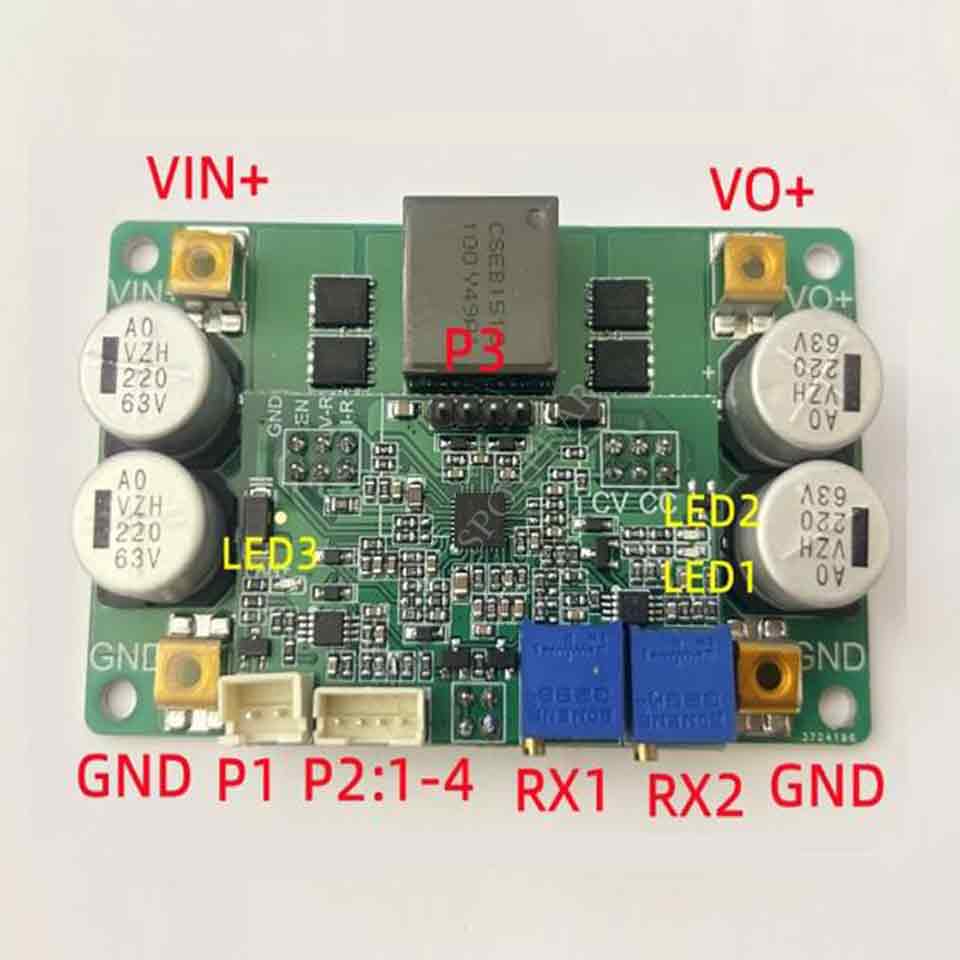
VIN+: Function: Power input positive pole. Function description: Input+. No communication allowed, no reverse connection allowed
GND: Function: Power input and output negative electrode. Function description: Public negative electrode
VO+: Function: Power output positive pole. Function description: Output positive pole, connect the positive and negative poles of the battery without reverse connection
RX1: Function: Output voltage regulation, increasing clockwise. Function description: 25 turns of the Potentiometer corresponds to a 2.0-56V change in output voltage. The life of the Potentiometer is limited, so frequent adjustment is not recommended. The Potentiometer shall not be open circuit, and the open circuit must be damaged by overvoltage.
RX2: Function: Output current adjustment, increasing clockwise. Function description: 25 turns of Potentiometer corresponds to 3-20A change of output limiting current. The specific current limit value needs to be measured in practice.
P1: Function: Temperature controlled fan 12V power supply interface (optional). Function description: Right represents+left represents -, and the current should not exceed 0.5A (auxiliary electrical board needs to be selected and VIN>13V)
P2-1: Function: Control signal GND. Function description: Connected to the negative electrode of EN enable and voltage and current control
P2-2: Function: Power EN enable interface. Function description: After pulling down GND, the entire power supply is turned off, including the auxiliary board. It is recommended to use this interface for external shutdown, as it has strong anti-interference ability.
P2-3: Function: Output voltage control interface (default unavailable). Function description: only one of Potentiometer and voltage control can be selected, which needs to be modified and Potentiometer removed. The external control voltage of 0-2.4V corresponds to a change in control output voltage of 0-56V, which is a positive proportion.
P2-4: Function: Output current control interface (default not available). Function description: Interface voltage 0-2.4V corresponds to a control output current of 2-20A. RX2 needs to be counterclockwise to the bottom and controlled as non-linear. Adjustable proportion
P3: Function: Optional auxiliary board welding interface (VIN or VO needs to be>13V). Function description: This function is only available after selection, used to further adjust high efficiency, reduce heat generation, and provide voltage reduction and stable power supply for 12V fans
LED1: Function: The work indicator light is green. Function description: Illuminates when unloaded or at constant voltage output
LED2: Function: Constant current indicator light. Function description: Output current limiting voltage drop, output short circuit, output over temperature protection. This light is on and can be automatically restored
LED3: Function: Auxiliary power board indicator light (optional). Function description: After installing the auxiliary board, this light comes on, indicating that the auxiliary power is normal
Note:
1. The testing of this power supply must ensure that the input source can provide sufficient current (>22A) to ensure that the power supply does not collapse or even damage, especially when starting with load.
2. The startup time of the input source must be less than the startup time of the local power supply (such as the adapter as input), otherwise it may not be possible to start with load
3. The input wire connected to this power supply should not be too long (the internal resistance of the wire should not be too large), otherwise the power supply may cause vibration and abnormalities
4. If there is a diode connected in series from the input source to the local power supply, the power supply may be damaged due to the surge voltage caused by instantaneous switching on and off (line BOOST effect)
5. Do not use the cC mode of electronic loads as the load of this power supply, it is recommended to use the cR mode. The CC mode absorbs current, which limits the current of the power supply. In a constant current state, it will cause the power supply to crash
6. It is recommended to connect the output voltage to a small current resistance load (dummy load) to ensure the real-time adjustment of the output voltage Potentiometer. Otherwise, the output voltage changes slowly and the adjustment value is inaccurate.
【Outline Dimensions】
